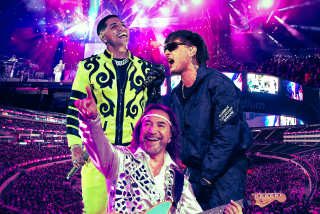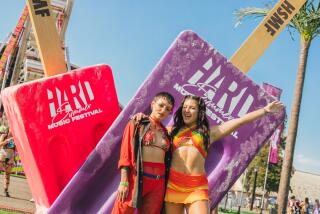Dance music grooves to the fore
On a recent afternoon, Gary Richards was standing in his Hollywood office in front of a detailed map of the Los Angeles State Historic Park, the 36-acre plot just east of Chinatown. Richards, who has promoted dozens of gatherings under the moniker Hard Events, is planning his first parties on public land, and, as he’s learned by now, a new venue requires extra attention.
FOR THE RECORD:
Summer dance music events: An article last Sunday about the summer’s dance music events said that the Electric Daisy Carnival on June 25-26 and Love Festival on Aug. 21 would take place at the Los Angeles Coliseum. The Electric Daisy Carnival will take place at Exposition Park as well as the Coliseum. The Love Festival will take place at Exposition Park and the Los Angeles Sports Arena. —
Where will the thousands enter? How much electricity will be needed? Through which hidden corners will the gate-crashers try to sneak?
He pointed to a rendering of the main stage grounds, where, on the first of two summer dates he has slated for the site, on July 17, superstar singer/rapper M.I.A. will perform as part of an event called Hard LA. “This holds about 20,000 people,” he said, “and right here is the second stage, which holds about 7,000 people.”
Since he started promoting dance music events after 15 years spent in the record business, Richards, 39, has booked shows at, among others, the Hollywood Palladium, the Orion Theatre and the Shrine. But as the masses flock to the dance floor in increasing numbers, he and other promoters are looking for bigger venues to contain the crowds, and are expanding beyond Southern California. Hard Events has done events in L.A., New York, Miami and San Francisco.
Last year, over two days, Insomniac Events’ party Electric Daisy Carnival, now in its 14th year, drew a reported 135,000 people to the Los Angeles Coliseum for a rave that featured carnival rides, a sculpture park and dozens of the world’s most popular DJs. This summer’s installment, which takes place on June 25 and June 26 at the Coliseum, promises to be just as big, and will feature, among others, Moby, MSTRKRFT, Steve Aoki, Deadmau5 and Z-Trip. Another annual rave, the Love Festival, will take over the Coliseum on Aug. 21.
While Coachella, Bonnaroo and other massive rock and pop festivals have higher public profiles, the electronic dance music scene has been exploding. Fueled by a roster of parties and an inclusive philosophy that absorbs the sounds of rock, hip hop and pop music and transforms them via remixes into beat-heavy dance floor fodder, electronic dance music is virtually inescapable this summer.
The DJs who play the events follow a business model ideally designed for today’s marketplace – little reliance on sales from recorded music, but huge payouts for live performances. The biggest names, like Tiesto, David Guetta and Deadmau5, can make as much money as pop stars, without nearly the public profile.
“I think it’s always a little shocking to people when they realize how big the scene is, how big it’s been and how long it’s been around,” said Jason Bentley, music director of KCRW-FM, host of the station’s “Morning Becomes Eclectic” and longtime dance music DJ. “But it’s the nature of that scene.”
Unlike in the early days of rave culture, when secret parties occurred at untested – and often illegal -- locations, the music, which enjoyed a brief run at the pop charts in the late 1990s when Moby, the Chemical Bros. and the Prodigy had hits, has over the past two decades moved from dingy spaces and secret desert locations and into concert venues and stadiums. Recalled Richards of the first wave, in the early 1990s: “If I wanted to hear cool electronic music, I had to go to a warehouse at 3 a.m. in downtown LA, and risk my car getting broken into, and it was a crazy adventure.”
Such successes have forced the event promoters to transform what was once a renegade business into a legitimate model, said Pasquale Rotella, founder of Insomniac, which has promoted the Electric Daisy Carnival since the first one, at the Shrine Auditorium in downtown L.A. in 1997.
“We’re in a totally different business than we were then,” Rotella, 35, said. “Those early years were fun, but these days we do the same things that AEG or Live Nation would do in regards to organizing events and dealing with the proper authorities.”
In the last couple years, said Richards, the scene has evolved even further; guestlists at the major events are now teeming with pop star attendees. “Now Will.i.am is hanging out watching what we’re doing. They’re all coming. We’ve had Lil Jon, Perry Farrell, Noriega, Santigold. Tommy Lee was there. Everybody’s into it.”
Goldenvoice president Paul Tollett, who founded the Coachella Festival in 1999, said in an email that over the past decade the audience’s tastes have become less segregated. “In the first couple years of Coachella, the crowd was more separated by genre. Some of the electronic-leaning people stayed in the [dance] tents for most of the weekend, and the more alt-rock leaning ones watched the outdoor stages. Now it’s all over the place. No one prefers just one specific type of music anymore.”
With the mainstreaming of dance culture, the music, with it’s steady 128 beat-per-minute pulse and bass-heavy rhythmic thrust, has insinuated itself into the pop charts. Lady Gaga infuses the house sound of Chicago into her hits; Ne-Yo’s new “Beautiful Monster” is basically a trashy Euro-house track; Rihanna’s recent “Rude Boy,” features synthethizer chords that sound time-traveled from 1992; and Britney Spears is working with hot London producer and recent LA transplant Rusko. Those who don’t explicitly employ these sounds hire DJs to remix their hits for the dance floor.
Of course, co-opting the underground isn’t new, said KCRW’s Bentley. “ Madonna’s made a career of it. But every pop star has had to look to DJs, look to underground producers for that next sound. And maybe that’s the strength of the scene. The nature of the scene is always, ‘What’s next?’ It’s always pushing forward, innovating.”
Black Eyed Peas co-founder Will.i.am, who started going to first-generation LA raves when he was in his teens and whose 2009 hit, “I Gotta Feeling,” was produced by French house DJ David Guetta, said on the phone from Europe that it makes sense that pop artists are drawing inspiration from club culture. “When the music industry started collapsing, the logical people understood that the only place to go for shelter was the underground. If the world on the surface is burning up, and you know people that have bunkers, go to the bunkers.”
And the DJs in those hideaways can afford luxury in 2010, he added. “A DJ can make $500,000 a year and never put out a record and the song doesn’t play on the radio.” He said he knows one big-name DJ who pulled in $20 million last year.
Electric Daisy Carnival’s Rotella said that he has watched a shift take place, though. “It didn’t used to be that when a DJ got off the stage you’d have to have a security escort them and control the amount of people who are looking for them to sign a shirt. That’s something that’s been growing for the past five years.”
The transformation isn’t just happening at the massive stadium and open-air events, added Richards, who DJs around town under the name Destructo. “Now, every club in Hollywood has a house night. I can go play at USC for the USC crowd, but then I can also go play for the bottle service crowd. Everyone’s into it right now -- even my wife.” Smaller raves still happen in the Los Angeles underground, as well, and an electronic scene centered around weekly club the Low End Theory has drawn international attention.
Pete McGowin, 28, is a dance music fan and former hip hop MC who now raps over dance beats. He’s been going to parties continuously since the mid-1990s, and has watched as the music he loves has worked its way onto the charts. “You turn on the radio now and even Power 106 – the hip hop station – is all dance music now,” he said. “From noon to 2 p.m. every day they have this ‘Powerhouse Mix,’ and it’s all electro, house – all these remixes from these artist like Black Eyed Peas or whoever.”
The first parties that he attended, he said, were an epiphany. “It was a cool feeling seeing all these people getting down. People were breakdancing, and the way they dressed was cool. It was so many different cultures, different races, coming together. There was such an energy.”
It’s an energy that has sustained itself overseas without interruption in hotspots like London, Berlin and Ibiza since the music’s rise. In America, Los Angeles in particular has managed to thrive even during down years at the turn of the last decade, when the media became obsessed with raves, ecstasy use among teenagers was rampant and sketchy promoters tried to make a quick buck.
Insomniac Events, said Pasquale, survived the lean years, but it was tough. “Basically, all the rave promoters went out of business. We didn’t go out of business because we weren’t doing those kinds of events. But it was good for us. It was like a cleansing of the industry.” Those who suffered the most, he said, were the ones who weren’t obtaining the proper permits and got their parties shut down .
Bentley said those difficult years were necessary. “The scene has undergone some real growing pains over the years -- doing it at legitimate, above-ground venues. Promoters don’t want to be arrested or run out of the state, and all of that has happened. DJs have been taken into custody. So it had to go legitimate at some point.”
He saw the success of those efforts at last year’s Electric Daisy Carnival, where he watched the throngs from a skybox. “You look down on the Coliseum and it’s packed with kids and you’re thinking, ‘Who’s on stage? Is this the Led Zeppelin reunion or something?’ For the enthusiasm and number of people -- the sheer number -- you think, this has got to be huge.”
Gary Richards said that the volume of people is proof of a theory that Erol Alkan, who is playing Hard’s second event, Hard Summer, on August 7, has: “[He] once said to me,’Dance music is like the flu. It goes away, but then it always comes back stronger.’”
More to Read
Sign up for The Wild
We’ll help you find the best places to hike, bike and run, as well as the perfect silent spots for meditation and yoga.
You may occasionally receive promotional content from the Los Angeles Times.






